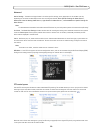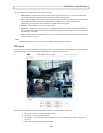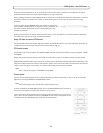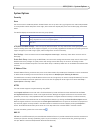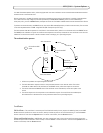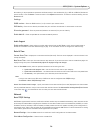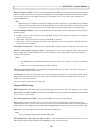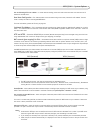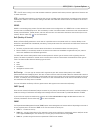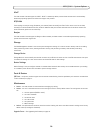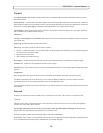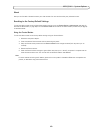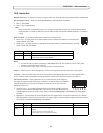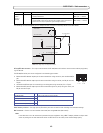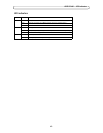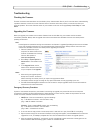
37
AXIS Q7401 - System Options
FTP - The FTP server running in the video encoders enables the upload of new firmware, and user applications. Check the box
to enable the service.
RTSP - The RTSP protocol allows a connecting client to start an H.264 stream. Check the box to enable the server and enter
the RTSP port number to use. The default setting is 554. Note that H.264 video streams will not be available if this service is
not enabled.
SOCKS
SOCKS is a networking proxy protocol. The Axis video encoder can be configured to use a SOCKS server to reach networks on
the other side of a firewall/proxy server. This functionality is useful if the video encoder is located on a local network behind a
firewall, and notifications, uploads, alarms, and such need to be sent to a destination outside the local network (such as the
Internet). See the online help for more information.
QoS (Quality of Service)
Quality of Service (QoS) guarantees a certain level of a specified resource to selected traffic on a network. Quality can be
defined as a maintained level of bandwidth, low latency, and no packet losses. The main benefits of a QoS-aware network can
be summarized as:
• The ability to prioritize traffic and thus allow critical flows to be served before flows with lesser priority.
• Greater reliability in the network, thanks to the control of
the amount of bandwidth an application may use, and thus
control over bandwidth races between applications.
The QoS in Axis network video products marks the data packets for various
types of network traffic originating from the
product. This makes it possible for network routers and switches to reserve a fixed amount of bandwidth for these types of
traffic. The video encoders mark the following types of traffic:
•video
•audio
•event/alarm
• management network traffic
QoS Settings - For each type of network traffic supported by your Axis network video product, enter a DSCP
(Differentiated Services Codepoint) value. This value is used to mark the traffic’s IP header. When the marked traffic reaches a
network router or switch, the DSCP value in the IP header tells the router or switch the type of treatment to apply to this type
of traffic, for example, how much bandwidth to reserve for it. Note that DSCP values can be entered in decimal or hex form,
but saved values are always shown in decimal.
For more information on Quality of Service,
please see the Axis support web at www.axis.com/techsup
SMTP (email)
Enter the host names (or IP addresses) and port numbers for your primary and secondary mail servers in the fields provided, to
enable the sending of notifications and image email messages from the video encoder to predefined addresses via SMTP.
If your mail server requires authen
tication, check the box for Use authentication to log in to this server and enter the
necessary information. See the online help for more information.
SNMP
The Simple Network Management Protocol (SNMP) allows remote management of network devices. Depending on the level of
security required, select the version of SNMP to use. The three levels of security are:
• SNMP V1 - includes no security.
• SNMP V2c - uses very simple security. The community
name can be specified as a password for read or read/write access
to all supported SNMP objects. The community is the the group of network devices using SNMP.
• SNMP V3 - provides encryption and secure passwords. HTTPS
must be enabled.



